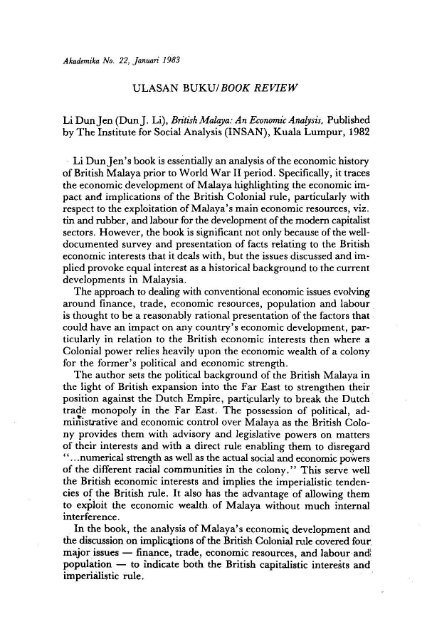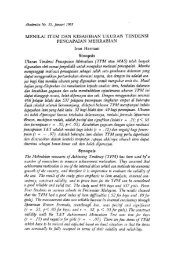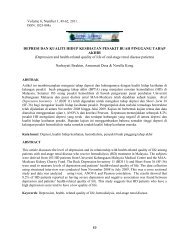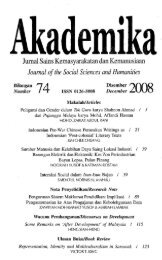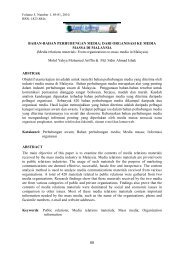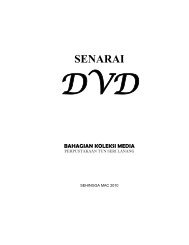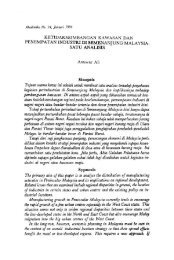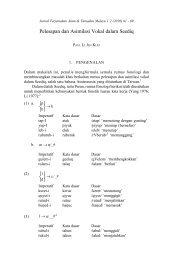ULASAN BUKUIBOOK REVIEW Li Dun Jen (Dun J. Li), British ...
ULASAN BUKUIBOOK REVIEW Li Dun Jen (Dun J. Li), British ...
ULASAN BUKUIBOOK REVIEW Li Dun Jen (Dun J. Li), British ...
Create successful ePaper yourself
Turn your PDF publications into a flip-book with our unique Google optimized e-Paper software.
Akndrmika No. 22, Jonuari 1983<br />
<strong>ULASAN</strong> <strong>BUKUIBOOK</strong> <strong>REVIEW</strong><br />
<strong>Li</strong> <strong>Dun</strong> <strong>Jen</strong> (<strong>Dun</strong> J. <strong>Li</strong>), <strong>British</strong> Mahya: An Economic Am[YSis, Published<br />
by The Institute for Social Analysis (INSAN), Kuala Lumpur, 1982<br />
<strong>Li</strong> <strong>Dun</strong> <strong>Jen</strong>'s book is essentially an analysis of the economic history<br />
of <strong>British</strong> Malaya prior to World War I1 period. Specifically, it traces<br />
the economic development of Malaya highlighting the economic im-<br />
pact and implications of the <strong>British</strong> Colonial rule, particularly with<br />
respect to the exploitation of Malaya's main economic resources, viz.<br />
tin and rubber, and labour for the development of the modem capitalist<br />
sectors. However, the book is significant not only because of the well-<br />
documented survey and presentation of facts relating to the <strong>British</strong><br />
economic interests that it deals with, but the issues discussed and im-<br />
plied provoke equal interest as a historical background to the current<br />
developments in Malaysia.<br />
The approach to dealing with conventional economic issues evolving<br />
around finance, trade, economic resources, population and labour<br />
is thought to be a reasonably rational presentation of the factors that<br />
could have an impact on any country's economic development, par-<br />
ticularly in relation to the <strong>British</strong> economic interests then where a<br />
Colonial power relies heavily upon the economic wealth of a colony<br />
for the former's political and economic strength.<br />
The author sets the political background of the <strong>British</strong> Malaya in<br />
the light of <strong>British</strong> expansion into the Far East to strengthen their<br />
position against the Dutch Empire, particularly to break the Dutch<br />
trade monopoly in the Far East. The possession of political, ad-<br />
mi:istrative and economic control over Malaya as the <strong>British</strong> Colo-<br />
ny provides them with advisory and legislative powers on matters<br />
of their interests and with a direct rule enabling them to disregard<br />
"...numerical strength as well as the actual social and economic powers<br />
of the different racial communities in the colony." This serve well<br />
the <strong>British</strong> economic interests and implies the imperialistic tenden-<br />
cies of the <strong>British</strong> rule. It also has the advantage of allowing them<br />
to exploit the economic wealth of Malaya without much internal<br />
interference.<br />
In the book, the analysis of Malaya's economic development and<br />
the discussion on implications of the <strong>British</strong> Colonial rule covered four<br />
major issues - finance, trade, economic resources, and labour and!<br />
population - to indicate both the <strong>British</strong> capitalistic intereits and<br />
imperialistic rule.
The analysis and discussion emplicitly indicates that revenues of<br />
Malaya had been generously used towards financing imperial defense<br />
in addition to expenditure on public works, etc. and for the general<br />
economic development. The expenditures on education and medical<br />
services has never been important. This implies not only imperialism<br />
at work, but also, more significantly, the capitalist interest in laying<br />
infrastructural foundations through improvement and development<br />
of public works for the convenience of extracting as well as exploiting<br />
the Colony's economic wealth. Another interesting issue relates to<br />
trade. The author indicates that the exports of tin and rubber had<br />
so dominated the total export trade that other exports were com-<br />
paratively insignificant. In fact, tin and rubber became an impor-<br />
tant economic assets to the extent that Malaya has been considered<br />
the "dollar arsenal" of Great Britain and this serves well the <strong>British</strong><br />
economic interests. There was, however, little development trickling<br />
down to the Colony except for infrastructures serving the needs and<br />
interests of the Colonial power" for the continuous exploitation of<br />
Malaya's natural resources". In terms of import trade, the im-<br />
perialistic as well as the exploitative and capitalistic tendencies emerged<br />
where Malaya became the largest importer of <strong>British</strong> Empire pro-<br />
ducts. Again, it serves well the <strong>British</strong> economic interests.<br />
The exploitation of rubber and tin are, not suprisingly, undertaken<br />
towards the gradual assumption of control over both industries by<br />
the <strong>British</strong> because they carry economic significance. At the same time,<br />
the author indicates be shrewd manipulations by the <strong>British</strong> for<br />
"domination" in these industries at the .expense of rubber<br />
smallholdings and small tin producers. Their capitalistic interests fur-<br />
ther materialise with the help of the influx of immigrant labour, viz.<br />
the Chinese for the tin mines and the Indians for rubber plantations.<br />
This foreign-origin capital provided for the exploitation of Malaya's<br />
natural resources was considered necessary and it serves the <strong>British</strong><br />
capitalistic tendency as they were cheap and easily controlled.<br />
The picture that emerges reflects clearly that Malaya as a <strong>British</strong><br />
Colony has been economically beneficial to the <strong>British</strong> Empire. At<br />
the same time, tin an rubber also provide the forces behind most of<br />
the fortunes and successes in the economic development of Malaya<br />
itself. In addition, the <strong>British</strong> economic interests in Malaya has given<br />
the Malayan population its cosmopolitan character; and this, to alarge<br />
extent, created the roots of the preasent social, economic and ~olitical<br />
developments in Malaysia.<br />
It should be noted that inasmuch as the Malays, representing the<br />
largest ethnic group in Malaya, were neglected in developing the
economic base and foundation of the Colony's development, viz. the<br />
modern sectors of tin and rubber, on the assumption that the Malays<br />
are " ... as 'Nature's gentlemen' fond of 'simple life' in agriculture<br />
and fishing" and "were not active participants in modern enterprises<br />
and were satisfied with being left alone", it may also be the result<br />
of the <strong>British</strong> capitalist interests tending to prefer cheap labour for<br />
maximum profits as the author plainly states that "the sole purpose<br />
of encouraging alien immigrants to come to Malaya was to provide<br />
the capitalists with a labour force willing and able to exploit the hid-<br />
den resources of that rich country". Moreover, the <strong>British</strong> were known<br />
to have adopted a "divide and rule policy" during their control over<br />
Malaya to avoid and reduce internal political problems. As it seems,<br />
the Malays then were never given the opportunity or encouraged to<br />
participate in (modem) economic activities other than their traditional<br />
agricultural activities; thus depriving the Malays of (modem) economic<br />
opportunities. Even in administrative matters, it was only the Rulers<br />
who were consulted and that only pertaining to matters relating to<br />
"the Muhammadan religion and Malay customs". The manipula-<br />
tions by the <strong>British</strong> are so shrewd that "though they (the Rulers)<br />
possesed this power, the <strong>British</strong> advisers saw to it that it was rarely<br />
exercised"<br />
The entire analysis in the book has been closely related to the preyn-<br />
tation of facts from documents. While it has served the purpose of<br />
a historical approach to economic development in relation to the <strong>British</strong><br />
impel.ialism and economic interests as well as the development of<br />
modern capitalist sectors in Malaya, it has however neglected discuss-<br />
ing some detailed and salient issues that may have significant con-<br />
tribution to or influence on the existing status quo. On the whole,<br />
the book is a positive contribution to the understanding of the economic<br />
history of Malaya. It not only contains an analytical presentation of<br />
documented facts and, for most part, quite clearly and dispassionately<br />
written and discussed, but it also provides a sound historical account<br />
and an economic analysis significant to the understanding of the Col-<br />
onial heritage and the present existing social, economic and political<br />
scenarios in Malaysia. In fact, as history often repeats itself, the book<br />
highlights some economic and political issues as lessons that can be<br />
useful for a meaningiul economic development of Malaysia. However,<br />
as the author himself is aware, there involved controversial issues where<br />
detailed analysis and judgements were not attempted; and as such,<br />
this book should be treated, among others, as an economic historv<br />
of the development of Malaya under the <strong>British</strong> rule prior to World<br />
War 11, viz. the Colonial heritage.<br />
Zulkifly Hj. Mustapha<br />
Universiti Kebangsaan Malaysia
----<br />
AKADEMZKA AKADEMZKA AKADEMZKA AKADEMIKA AKADEMIKA AKADEMZKA AKADEMZKA AKADEMZKA<br />
Hantarkan pesanan tuan kepada: PENERBIT UNIVERSITI KEBANGSAAN MALAYSIA,<br />
Send your orders to Universiti Kebangsaan Malaysia, Bangi, Selangor, MALAYSIA.<br />
Akadrmika, BilINo. 1, Julai 1972<br />
Akadmika, BilINo. 2, January 1973<br />
Akadrmika, BilINo. 3, Julai 1973<br />
Akadrmika, BillNo. 4, Januari 1974<br />
Akadmika, BilINo. 5, Julai 1974<br />
Akadmika, BilINo. 6, Januari 1975<br />
Akadrmiko, BillNo. 7, Julai 1975<br />
Akadmika, BillNo. 8, Januari 1976<br />
Akadrmika, BilINo. 9, Julai 1976<br />
Akadrmika, BillNa. 10, Januari 1977<br />
PoslPortagc; Tambahanladd M110.40 senaskhahlplr copy<br />
Akndrmikn, BilINo. 11, Julai 1977 5.00<br />
Akadrmika, BillNo. 12, Januari 1978 5.00<br />
Akndrmika, BiilNo. 13, Julai 1978 5.00<br />
Akndrmika, BiYNo. 14, Januari 1979 5.00<br />
Akndrmika, BiYNo. 15, Julai 1979 5.a)<br />
Akndrmiha, BiYNo. 16, Januari 1980 5.00<br />
Akndrmika, BillNa. 17, Julai 1980 5.00<br />
Akndrmika, BiVNo. 18. Januari 1981 10.00<br />
Akadrmika, BillNo. 19, Julai 1981 10.00<br />
PoslP05Qc:<br />
Jumlah penuhlTotal pricc: MI<br />
Bayar bank drafkiriman wang atas namalMdwyour bank draflmncy ordcrspayobL lo: Bendahari, Univeraiti Kebangsaan Malaysia<br />
Harap paskan jurnal kepadalPlcorc moil the joumnlr orhred to:<br />
Disertakanlattuhed: Bank draflbank dmftlKiriman WanglMoncy Ordm No: TandatanganlSiptwc..


